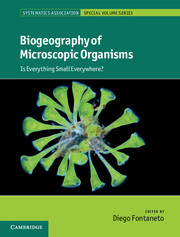Book contents
- Frontmatter
- Contents
- List of contributors
- Preface
- Part I Theoretical framework
- Part II Prokaryotes
- Part III Unicellular eukaryotes
- 5 Dispersal of protists: the role of cysts and human introductions
- 6 Everything is everywhere: a twenty-first century de-/reconstruction with respect to protists
- 7 Arcellinida testate amoebae (Amoebozoa: Arcellinida): model of organisms for assessing microbial biogeography
- 8 Everything is not everywhere: the distribution of cactophilic yeast
- Part IV Pluricellular eukaryotes
- Part V Processes
- Index
- Systematics Association Publications
- Systematics Association Special Volumes
- Plate section
- References
7 - Arcellinida testate amoebae (Amoebozoa: Arcellinida): model of organisms for assessing microbial biogeography
from Part III - Unicellular eukaryotes
Published online by Cambridge University Press: 05 August 2012
- Frontmatter
- Contents
- List of contributors
- Preface
- Part I Theoretical framework
- Part II Prokaryotes
- Part III Unicellular eukaryotes
- 5 Dispersal of protists: the role of cysts and human introductions
- 6 Everything is everywhere: a twenty-first century de-/reconstruction with respect to protists
- 7 Arcellinida testate amoebae (Amoebozoa: Arcellinida): model of organisms for assessing microbial biogeography
- 8 Everything is not everywhere: the distribution of cactophilic yeast
- Part IV Pluricellular eukaryotes
- Part V Processes
- Index
- Systematics Association Publications
- Systematics Association Special Volumes
- Plate section
- References
Summary
Introduction
Although widely recognised as essential participants in ecosystem processes and representing a significant part of the Earth's biodiversity (Clarholm, 1985; Corliss, 2002; Schröter et al., 2003; Falkowski et al., 2004), eukaryotic microorganisms are very poorly understood from evolutionary and biogeographic points of view. Major questions concerning the diversity and the distribution of protists remain completely unresolved. Arcellinida testate amoebae are an excellent group from which to get insights into these questions because they are easy to collect, present in different habitats and they build a shell of characteristic morphology that remains even after the organism's death. In this group, both cosmopolitan and restricted distribution patterns have been documented. Some morphospecies such as Apodera vas(=Nebela vas), Alocodera cockayni or the whole genus Certesella have been reported as one of the most convincing examples of heterotrophic protists with restricted distributions (Foissner, 2006; Smith and Wilkinson, 2007; Smith et al., 2008). Arcellinida testate amoebae belong to the eukaryotic supergroup Amoebozoa (Nikolaev et al., 2005) and are morphologically characterised by the presence of lobose pseudopodia and a shell (test) composed from proteinaceous, calcareous or siliceous material. It can be either self-secreted or composed of recovered and agglutinated material. The Arcellinida covers a relatively broad range of sizes (mostly between 20 and 250 μm).
- Type
- Chapter
- Information
- Biogeography of Microscopic OrganismsIs Everything Small Everywhere?, pp. 111 - 129Publisher: Cambridge University PressPrint publication year: 2011
References
- 12
- Cited by



